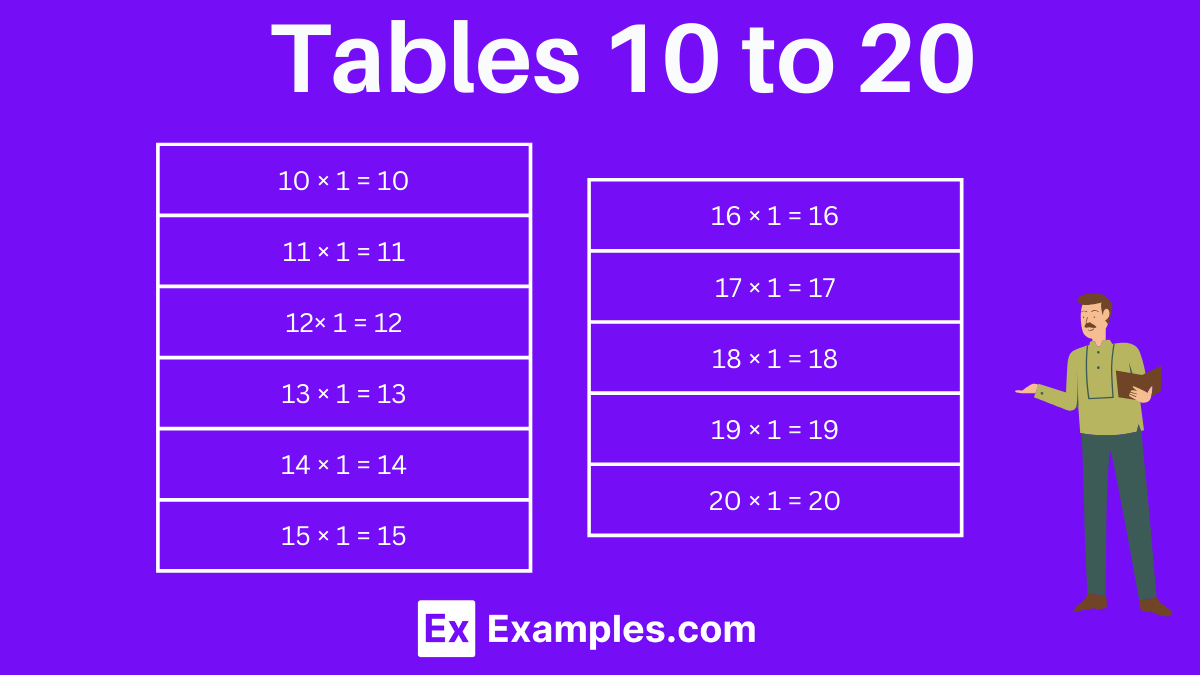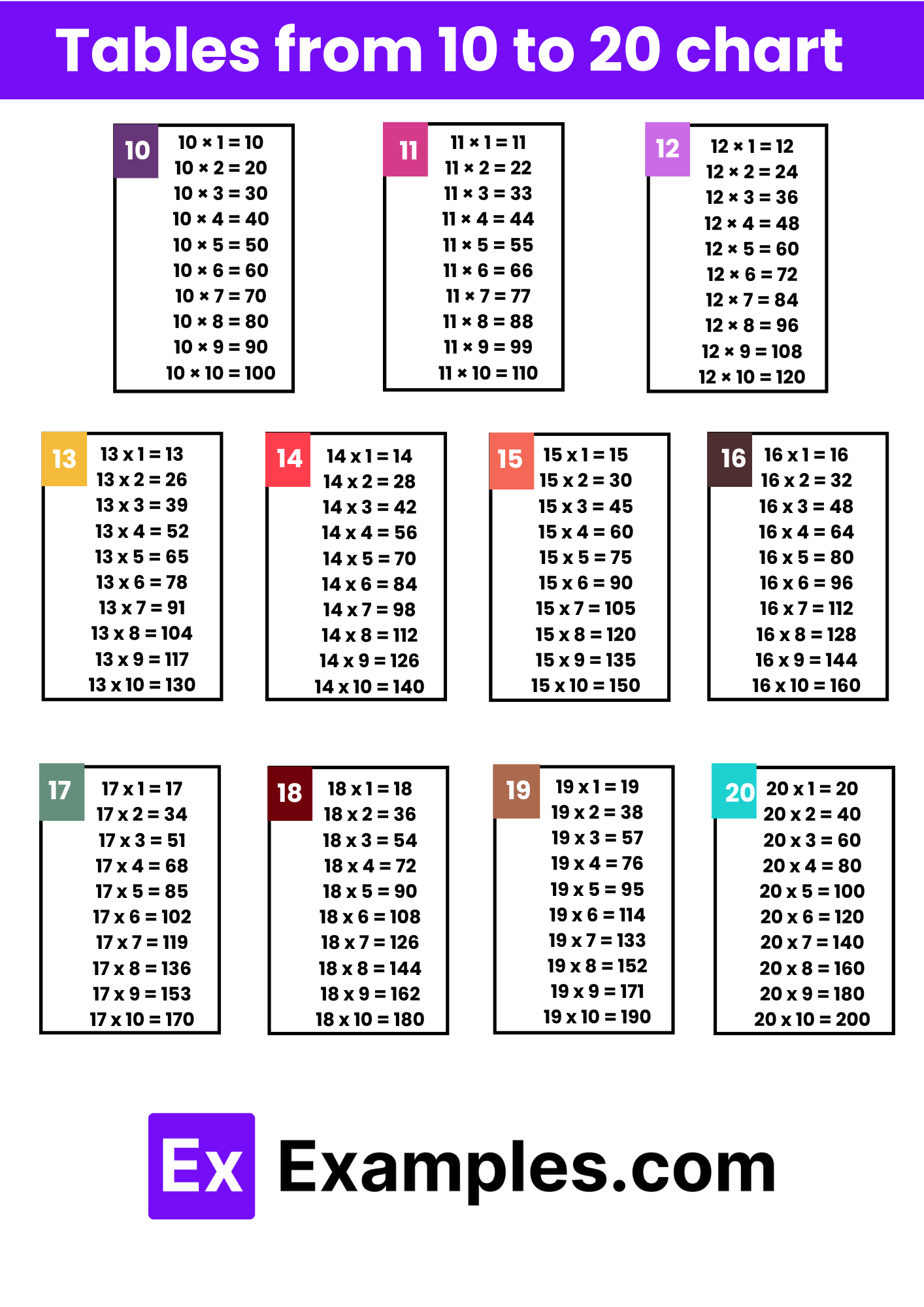What is 7 × 12?
84
76
90
72


The multiplication tables from 10 to 20 encapsulate essential mathematical forms, vital for advancing arithmetic skills. These tables expand students’ understanding of number relationships and multiplication patterns, critical for solving higher-level math problems efficiently and accurately.

Download Tables From 10 to 20 Chart Pdf
The multiplication chart for tables from 10 to 20 is a crucial mathematical tool that extends beyond basic multiplication, facilitating a deeper comprehension of number patterns and relationships. This chart is particularly beneficial for students transitioning to higher maths, as it solidifies their ability to handle complex calculations. By systematically presenting the products of numbers between 10 and 20, it enhances the mathematical form and understanding necessary for tackling advanced concepts and applications in algebra and beyond.
Download Tables From 10 to 20 Chart Pdf
| Tables 10 to 20 | Table 10 | Table 11 | Table 12 |
| Table 13 | Table 14 | Table 15 | Table 16 |
| Table 17 | Table 18 | Table 19 | Table 20 |
| 10 Table | 11 Table | 12 Table |
|---|---|---|
| 10 x 1 = 10 | 11 x 1 = 11 | 12 x 1 = 12 |
| 10 x 2 = 20 | 11 x 2 = 22 | 12 x 2 = 24 |
| 10 x 3 = 30 | 11 x 3 = 33 | 12 x 3 = 36 |
| 10 x 4 = 40 | 11 x 4 = 44 | 12 x 4 = 48 |
| 10 x 5 = 50 | 11 x 5 = 55 | 12 x 5 = 60 |
| 10 x 6 = 60 | 11 x 6 = 66 | 12 x 6 = 72 |
| 10 x 7 = 70 | 11 x 7 = 77 | 12 x 7 = 84 |
| 10 x 8 = 80 | 11 x 8 = 88 | 12 x 8 = 96 |
| 10 x 9 = 90 | 11 x 9 = 99 | 12 x 9 = 108 |
| 10 x 10 = 100 | 11 x 10 = 110 | 12 x 10 = 120 |
| 13 Table | 14 Table | 15 Table | 16 Table |
|---|---|---|---|
| 13 x 1 = 13 | 14 x 1 = 14 | 15 x 1 = 15 | 16 x 1 = 16 |
| 13 x 2 = 26 | 14 x 2 = 28 | 15 x 2 = 30 | 16 x 2 = 32 |
| 13 x 3 = 39 | 14 x 3 = 42 | 15 x 3 = 45 | 16 x 3 = 48 |
| 13 x 4 = 52 | 14 x 4 = 56 | 15 x 4 = 60 | 16 x 4 = 64 |
| 13 x 5 = 65 | 14 x 5 = 70 | 15 x 5 = 75 | 16 x 5 = 80 |
| 13 x 6 = 78 | 14 x 6 = 84 | 15 x 6 = 90 | 16 x 6 = 96 |
| 13 x 7 = 91 | 14 x 7 = 98 | 15 x 7 = 105 | 16 x 7 = 112 |
| 13 x 8 = 104 | 14 x 8 = 112 | 15 x 8 = 120 | 16 x 8 = 128 |
| 13 x 9 = 117 | 14 x 9 = 126 | 15 x 9 = 135 | 16 x 9 = 144 |
| 13 x 10 = 130 | 14 x 10 = 140 | 15 x 10 = 150 | 16 x 10 = 160 |
| 17 Table | 18 Table | 19 Table | 20 Table |
|---|---|---|---|
| 17 x 1 = 17 | 18 x 1 = 18 | 19 x 1 = 19 | 20 x 1 = 20 |
| 17 x 2 = 34 | 18 x 2 = 36 | 19 x 2 = 38 | 20 x 2 = 40 |
| 17 x 3 = 51 | 18 x 3 = 54 | 19 x 3 = 57 | 20 x 3 = 60 |
| 17 x 4 = 68 | 18 x 4 = 72 | 19 x 4 = 76 | 20 x 4 = 80 |
| 17 x 5 = 85 | 18 x 5 = 90 | 19 x 5 = 95 | 20 x 5 = 100 |
| 17 x 6 = 102 | 18 x 6 = 108 | 19 x 6 = 114 | 20 x 6 = 120 |
| 17 x 7 = 119 | 18 x 7 = 126 | 19 x 7 = 133 | 20 x 7 = 140 |
| 17 x 8 = 136 | 18 x 8 = 144 | 19 x 8 = 152 | 20 x 8 = 160 |
| 17 x 9 = 153 | 18 x 9 = 162 | 19 x 9 = 171 | 20 x 9 = 180 |
| 17 x 10 = 170 | 18 x 10 = 180 | 19 x 10 = 190 | 20 x 10 = 200 |
Example 1: Table of 10
Problem: 10 x 12 = ?
Solution: 10 x 12 = 120 (Ten multiplied by twelve equals one hundred twenty.)
Example 2: Table of 11
Problem: 11 x 9 = ?
Solution: 11 x 9 = 99 (Eleven times nine equals ninety-nine.)
Example 3: Table of 12
Problem: 12 x 15 = ?
Solution: 12 x 15 = 180 (Twelve multiplied by fifteen yields one hundred eighty.)
Example 4: Table of 13
Problem: 13 x 11 = ?
Solution: 13 x 11 = 143 (Thirteen times eleven results in one hundred forty-three.)
Example 5: Table of 14
Problem: 14 x 18 = ?
Solution: 14 x 18 = 252 (Fourteen multiplied by eighteen equals two hundred fifty-two.)
Example 6: Table of 15
Problem: 15 x 16 = ?
Solution: 15 x 16 = 240 (Fifteen times sixteen yields two hundred forty.)
Example 7: Table of 16
Problem: 16 x 13 = ?
Solution: 16 x 13 = 208 (Sixteen times thirteen equals two hundred eight.)
Example 8: Table of 17
Problem: 17 x 15 = ?
Solution: 17 x 15 = 255 (Seventeen multiplied by fifteen results in two hundred fifty-five.)
Example 9: Table of 18
Problem: 18 x 17 = ?
Solution: 18 x 17 = 306 (Eighteen times seventeen equals three hundred six.)
Example 10: Table of 19
Problem: 19 x 20 = ?
Solution: 19 x 20 = 380 (Nineteen times twenty yields three hundred eighty.)
Seek assistance from teachers, tutors, or online resources tailored to learning multiplication tables. Practice regularly and don’t hesitate to ask for help when needed.
Online resources such as apps, websites, and printable worksheets offer interactive ways to practice multiplication tables, including tables 10 and 20.
Memorize the key products like 10×10=100, 10×12=120, and 10×20=200, and practice regular repetition to reinforce memory retention.
Tables 10 and 20 are important because they form the basis for understanding multiplication, and their multiples are frequently used in various calculations and applications.
Focus on understanding the patterns, practice skip-counting by tens, and use mnemonic devices or visual aids to memorize the multiplication facts.
Text prompt
Add Tone
10 Examples of Public speaking
20 Examples of Gas lighting
What is 7 × 12?
84
76
90
72
Which of the following is the result of 15 × 13?
195
170
210
175
Find the product of 18 and 14.
252
260
224
280
What is 9 multiplied by 16?
144
153
162
136
Calculate 11 × 17.
187
200
244
280
What is the product of 13 and 19?
232
247
261
239
Determine the result of 20 × 10.
200
190
210
220
What is 12 times 15?
180
170
190
160
Find the result of 14 × 16.
218
220
224
230
What is 17 × 11?
187
198
176
169
Before you leave, take our quick quiz to enhance your learning!

